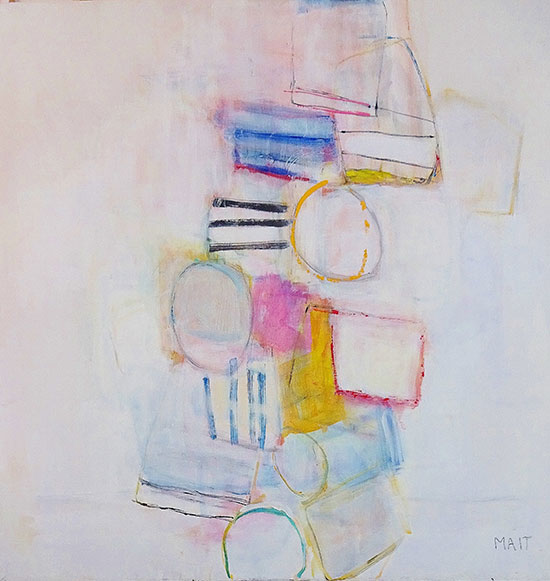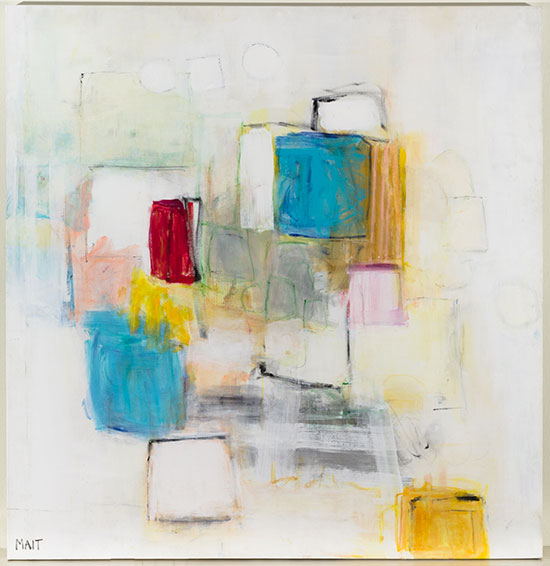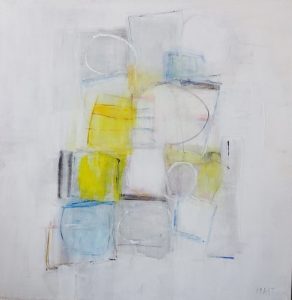A glorious spectrum dances in and out of contemporary abstract paintings in “Janet Mait: High Wire,” a gratifying solo exhibition at Lawrence Fine Art in East Hampton. With improvisatory elan, Mait fearlessly grabs the hand of each color and entices a full palette to the dance floor in a celebration of light.
In High Wire, the painting that lends its title to the show, the two-step of warm and cool keeps the cobalt blues and bubblegum pinks (shades of Philip Guston) on their toes. It sets the tempo for the exhibition in terms of composition as well, with the tumbling central column of drums and cubes flanked by the brilliant whites that Mait keeps in the wings.
.

"High Wire" by Janet Mait, 2016. Acrylic on canvas, 50 x 48 inches. Courtesy of Lawrence Fine Arts.
.
Mait is a sculptor by training who is clearly having a ball in her New York painting studio. According to the gallery biography, her paintings are held in the collection of Condé Nast. At the Art Students League she was a protégée of Chaim Gross, whose shimmying jazz dancers are vaguely suggested by the circular “head” and blurred, high-stepping red block forms of Jubilee. These forms also inevitably invoke the bold red rectangles of a Hans Hofmann painting.
.
"Jubilee" by Janet Mait, 2016. Acrylic on canvas, 50 x 48 inches. Courtesy of Lawrence Fine Arts.
.
The more important influences on the current show, I think, are her other teachers at the Art Students League: Larry Poons, who clearly released Mait’s passion for color, and William Scharf, an expert in line and composition who had apprenticed with Mark Rothko.
The Rothko legacy is in plain sight in Mait’s Gatsby, with its louvered horizontal bands of reds, blended blues and greens with lyrical drips. This painting is an anomaly in the show in terms of composition. Here they span from edge to edge, rather than central massed forms with white borders.
.
"Gatsby" by Janet Mait, 2016. Acrylic on canvas, 54 x 48 inches. Courtesy of Lawrence Fine Arts.
.
Gatsby, the painting, is also an anomaly by virtue of its literary source. It has the effervescence of the grand party scenes in F. Scott Fitzgerald’s masterpiece, conjuring the striped tents as well as the panoply of pinks and blues of Gatsby’s tailor-made shirts from London in the closet that so enraptured Daisy when she took a tour of the mansion. The painting also has some of the sense of unreality that Fitzgerald found in a word he repeated often, “caravansary.” It’s as though Mait were playing with the illusion of color’s insubstantiality on the canvas.
On my way home from the gallery, mulling the connection between The Great Gatsby—a book I revere in large measure for its understanding of evanescence and the price of fleeting pleasure—and the paintings to which I had been having such a pleasurable response, I began to have second thoughts about all that fun.
While it might seem foolish to complicate the pleasures of such an attractive show, I think one of the dangers of any kind of painting that appeals so directly to the senses, whether it be abstraction or photorealism, is the peril of facility. Like the popular lyricism of Dylan Thomas or Billy Collins, which can seem like poetry on tap, painting, if it is too easy, risks being taken for granted.
Working a little harder at sorting out what made the Mait paintings so effective, I thought of the various color theories that regard bright color in painting as a puzzle rather than just eye candy. Among these, I was reminded of the great classes in color theory that Josef Albers offered at Yale, which began with a caution to his students (including Richard Serra, Sol Lewitt, Judy Pfaff and so many others) that color is deceptive.
For another example, the philosophy of Ludwig Wittgenstein drilled deeply into the perceptual riddles posed by color. In his slim but brilliant and unfinished book, "Remarks on Color,” about the incompatibility of the sense of color from mind to mind, Wittgenstein offered this gem: “Among the colors: Kinship and Contrast.”
Taking that as my cue, I returned in a more serious mood to Mait’s Pyranees, a ghostlier work that has spectral whites and grays in washes, and the interaction of blues and golds in rapid brushwork. Like Fitzgerald, who flipped between flappers and philosophers, it has all the raucous elements of the color-mad paintings, but also interjects an elevating and welcome note of doubt, the kind of momentary struggle with the material qualities of color that makes Cezanne or Diebenkorn so admirable under similar conditions.
.

"Pyranees" by Janet Mait, 2014. 50 x 48 inches. Courtesy of Lawrence Fine Arts.
.
My respect was deepened by seeing the layers in the painting’s palimpsest, always mediated by curtains of white in various degrees of creaminess and brilliance. The painting explored Wittgenstein’s idea of “kinship” among the yellows or blues, and “contrast,” most dramatically between the sculptural black lines (not a major color for Mait) and the veils of white. The arabesque of geometric forms, irregularly traced, cascading in the center of this and other Mait paintings is under tension, with both gravity and the interaction of color.
The exhibition rewards a bit of work at the gallery, such as climbing the stairs toward the second floor for a better view in the stairwell of Blue Blush, a horizontal work that reads more as a still life than the figural suggestion of the vertical paintings. Its strongest marks are in red and black, but a haze of pink and orange in the upper right corner brings out Mait’s inner Bonnard.
A trio of drawings on paper reveal some of the warm-up exercises that give the improvisations their confidence. To see Wedding Bell Blues, the viewer has to step outside and peer through the window, but the extra effort pays off as the atmospheric greys and blues of this work start to hover into view.
.

"Wedding Bell Blues" by Janet Mait, 2016. Acrylic on canvas, 50 x 48 inches. Courtesy Lawrence Fine Art.
.
It’s summertime and there are always Gatsby-style parties to attend on the weekends after visiting the galleries in East Hampton. This parting glance at Mait’s painting in the window, with its delicately shimmering washes of blue, brought back for me one of those rhapsodic lines from The Great Gatsby in which the jazz of Fitzgerald’s finest prose is both music you can dance to and a reminder, with its blue notes, that the illusion eventually ends: “In his blue gardens men and girls came and went like moths among the whisperings and the champagne and the stars.”
___________________________________
BASIC FACTS: “Janet Mait: High Wire” is on view at Lawrence Fine Art from July 30 and is extended to August 18, 2016. Lawrence Fine Art is located at 37 Newtown Lane (in the passageway), East Hampton, NY 11937. www.Lawrence-fine-arts.com
___________________________________
Copyright 2016 Hamptons Art Hub LLC. All rights reserved.
